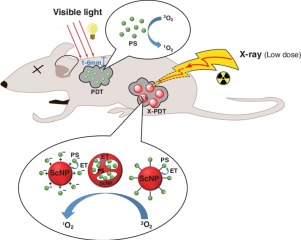Drug Discovery Today ( IF 6.5 ) Pub Date : 2018-05-24 , DOI: 10.1016/j.drudis.2018.05.029 Xu-Dong Ren , Xiu-Yun Hao , Hong-Cai Li , Mei-Rong Ke , Bi-Yuan Zheng , Jian-Dong Huang

|
In recent years, photodynamic therapy has been applied in cancer treatment because of its high selectivity and marginal invasion properties. However, the excitation light used has limited ability to penetrate tissue, which creates a stumbling block for its future development. To overcome this, X-rays have been introduced to transmit energy to deeper tissues. Given that a large number of X-ray-induced sensitizers have been designed to facilitate X-ray excitation and generate reactive oxygen species (ROS), this has led to the concept of X-ray-induced photodynamic therapy (X-PDT). After 10 years of development, this treatment now shows good therapeutic effects as well as shortcomings. Going forward, it will be important to improve tumor targeting and a standard deep-seated tumor model should be established.
中文翻译:

用于X射线诱导的光动力疗法的纳米增敏剂的开发进展
近年来,光动力疗法因其高选择性和边缘侵袭特性而被应用于癌症治疗。但是,所使用的激发光穿透组织的能力有限,这为其未来的发展创造了绊脚石。为了克服这个问题,已经引入了X射线将能量传输到更深的组织。鉴于已经设计了许多X射线诱导的敏化剂来促进X射线激发并产生活性氧(ROS),这导致了X射线诱导的光动力疗法(X-PDT)的概念。经过10年的发展,这种治疗方法现在显示出良好的治疗效果以及缺点。展望未来,重要的是要改善肿瘤靶向性,并应建立标准的深层肿瘤模型。









































 京公网安备 11010802027423号
京公网安备 11010802027423号